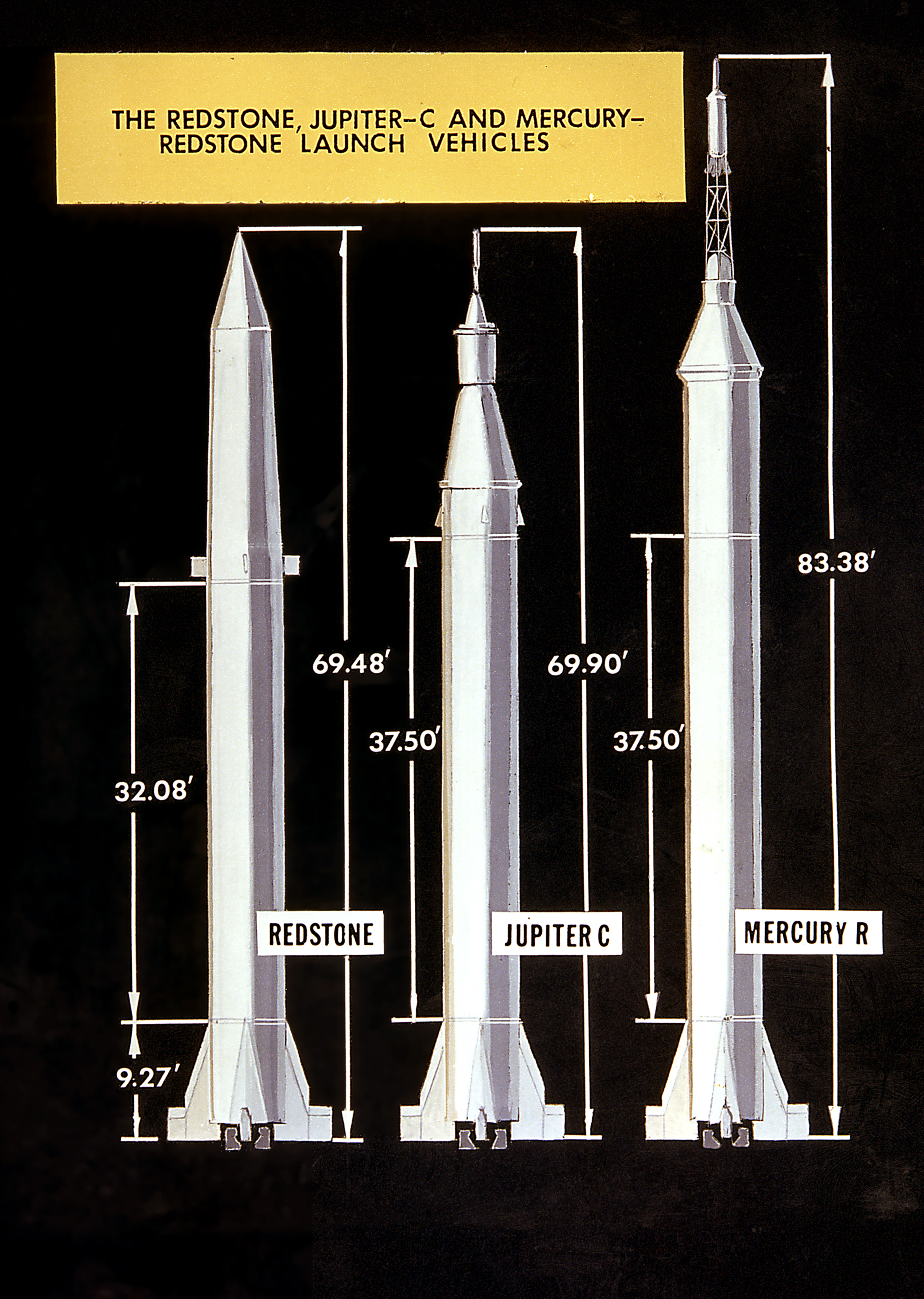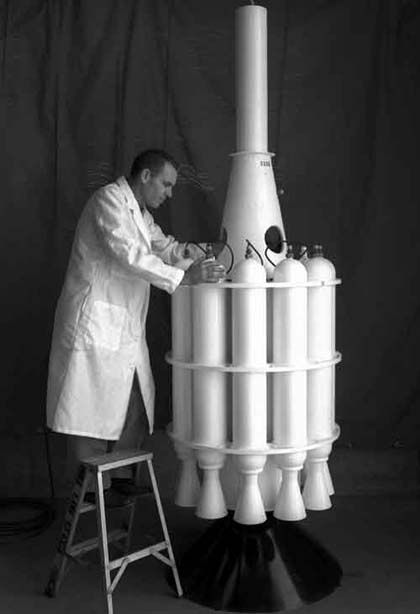Jupiter-C on:
[Wikipedia]
[Google]
[Amazon]
The Jupiter-C was an American research and development vehicle developed from the Jupiter-A. Jupiter-C was used for three uncrewed

 The second stage was an outer ring of eleven scaled-down
The second stage was an outer ring of eleven scaled-down
sub-orbital spaceflight
A sub-orbital spaceflight is a spaceflight in which the spacecraft reaches outer space, but its trajectory intersects the surface of the primary (astronomy), gravitating body from which it was launched. Hence, it will not complete one orbital ...
s in 1956 and 1957 to test re-entry nosecones that were later to be deployed on the more advanced PGM-19 Jupiter
The PGM-19 Jupiter was the first nuclear weapon, nuclear armed, medium-range ballistic missile (MRBM) of the United States Air Force (USAF). It was a liquid-propellant rocket using RP-1 fuel and Liquid oxygen, LOX oxidizer, with a single Rocketd ...
mobile missile. The recovered nosecone was displayed in the Oval Office as part of President Dwight D. Eisenhower's televised speech on November 7, 1957.
A member of the Redstone rocket family, Jupiter-C was designed by the U.S. Army Ballistic Missile Agency
The Army Ballistic Missile Agency (ABMA) was formed to develop the U.S. Army's first large ballistic missile. The agency was established at Redstone Arsenal on 1 February 1956, and commanded by Major General John B. Medaris with Wernher v ...
(ABMA), under the direction of Wernher von Braun
Wernher Magnus Maximilian Freiherr von Braun ( ; ; 23 March 191216 June 1977) was a German–American aerospace engineer and space architect. He was a member of the Nazi Party and '' Allgemeine SS'', the leading figure in the development of ...
.
Three Jupiter-C flights were made. These were followed by satellite launches with the vehicle designated as Juno I (see Juno I
The Juno I was a four-stage American space launch vehicle, used to launch lightweight payloads into low Earth orbit. The launch vehicle was used between January 1958 to December 1959. The launch vehicle is a member of the Redstone launch vehi ...
below or the Juno I
The Juno I was a four-stage American space launch vehicle, used to launch lightweight payloads into low Earth orbit. The launch vehicle was used between January 1958 to December 1959. The launch vehicle is a member of the Redstone launch vehi ...
article). All were launched from Cape Canaveral, Florida
Cape Canaveral is a city in Brevard County, Florida. It is part of the Palm Bay–Melbourne– Titusville Metropolitan Statistical Area. The population was 9,912 at the 2020 US census.
History
After the establishment of a lighthouse in 184 ...
.
Description
Each vehicle consisted of a modified Redstone ballistic missile with two solid-propellant upper stages. The tanks of the Redstone were lengthened by 8 ft (2.4 m) to provide additional propellant. The instrument compartment was also smaller and lighter than the Redstone's. The second and third stages were clustered in a "tub" atop the vehicle.
 The second stage was an outer ring of eleven scaled-down
The second stage was an outer ring of eleven scaled-down Sergeant
Sergeant (Sgt) is a Military rank, rank in use by the armed forces of many countries. It is also a police rank in some police services. The alternative spelling, ''serjeant'', is used in The Rifles and in other units that draw their heritage f ...
rocket engines; the third stage was a cluster of three scaled-down Sergeant rockets grouped within. These were held in position by bulkheads and rings and surrounded by a cylindrical outer shell. The webbed base plate of the shell rested on a ball bearing
A ball bearing is a type of rolling-element bearing that uses balls to maintain the separation between the bearing races.
The purpose of a ball bearing is to reduce rotational friction and support radial and axial loads. It achieves this ...
shaft mounted on the first-stage instrument section. Two electric motors spun in the tub at a rate varying from 450 to 750 rpm to compensate for thrust imbalance when the clustered motors fired. The rate of spin was varied by a programmer so that it did not couple with the changing resonance frequency of the first stage during flight.
The upper-stage tub was visibly spun-up before launch. During first-stage flight, the vehicle was guided by a gyro-controlled autopilot controlling both air-vanes and jet vanes on the first stage by means of servos. Following a vertical launch from a simple steel table, the vehicle was programmed so that it was traveling at an angle of 40 degrees from the horizontal at burnout of the first stage, which occurred 157 seconds after launch.
At first-stage burnout, explosive bolts fired and springs separated the instrument section from the first-stage tankage. The instrument section and the spinning tub were slowly tipped to a horizontal position by means of four air jets located at the base of the instrument section. When the apex of the vertical flight occurred after a coasting flight of about 247 seconds, a radio signal from the ground ignited the eleven-rocket cluster of the second stage, separating the tub from the instrument section. The third stage then fired to raise the apogee
An apsis (; ) is the farthest or nearest point in the orbit of a planetary body about its primary body. The line of apsides (also called apse line, or major axis of the orbit) is the line connecting the two extreme values.
Apsides perta ...
. Through this system, designed by Wernher von Braun
Wernher Magnus Maximilian Freiherr von Braun ( ; ; 23 March 191216 June 1977) was a German–American aerospace engineer and space architect. He was a member of the Nazi Party and '' Allgemeine SS'', the leading figure in the development of ...
in 1956 for his proposed Project Orbiter, the Jupiter-C obviated the need for a guidance system in the upper stages.
Juno I
TheJuno I
The Juno I was a four-stage American space launch vehicle, used to launch lightweight payloads into low Earth orbit. The launch vehicle was used between January 1958 to December 1959. The launch vehicle is a member of the Redstone launch vehi ...
was a satellite launch vehicle based on the Jupiter-C, but with the addition of a fourth stage, atop the "tub" of the third stage and the use of Hydyne as fuel. The Juno name derived from Von Braun wishing to make the satellite launch appear as peaceable as the Vanguard rocket, which was not a weapon, but was developed from a weather study rocket, the Viking
Vikings were seafaring people originally from Scandinavia (present-day Denmark, Norway, and Sweden),
who from the late 8th to the late 11th centuries raided, pirated, traded, and settled throughout parts of Europe.Roesdahl, pp. 9� ...
. Since the Juno I was the same height as the Jupiter-C (21.2 meters), with the added fourth stage being hidden inside the shell, this vehicle which successfully launched the first orbital satellite of the United States is often incorrectly referred to as a Jupiter-C.
Encrypted serial number
The Jupiter-C was part of theIRBM
An intermediate-range ballistic missile (IRBM) is a ballistic missile with a range between (), categorized between a medium-range ballistic missile (MRBM) and an intercontinental ballistic missile (ICBM). Classifying ballistic missiles by ran ...
project, and the sequence of manufacture of the rockets (which are not necessarily launched in order, and may be uprated as solutions to technical problems are worked out in tests) was considered a military secret. So the designation painted on the sides of the rocket was not a serial number in clear text, but employed a simple transformation cypher that the staff would be sure not to forget. The key was taken from the name of the design and test base: Huntsville, Alabama
Huntsville is the List of municipalities in Alabama, most populous city in the U.S. state of Alabama. The population of the city is estimated to be 241,114 in 2024, making it the List of United States cities by population, 100th-most populous ...
, giving HUNTSVILE, with duplicated letters dropped: H was used for 1, U for 2, ..., E for 9 and X for 0. For example, the Jupiter-C / Juno I modified to launch Explorer 1
Explorer 1 was the first satellite launched by the United States in 1958 and was part of the U.S. participation in the International Geophysical Year (IGY). The mission followed the first two satellites, both launched by the Soviet Union duri ...
had "UE" painted on the side, indicating it was S/N 29 (U→2, E→9).
General characteristics
* Weight as configured forExplorer 1
Explorer 1 was the first satellite launched by the United States in 1958 and was part of the U.S. participation in the International Geophysical Year (IGY). The mission followed the first two satellites, both launched by the Soviet Union duri ...
launch, loaded/empty
** Overall, takeoff: 64,000 lb (29,000 kg)/10,230 lb (4640 kg)
** Stage 1 62,700 lb (28,400 kg)/9,600 lb (4,400 kg)
** Stage 2 1,020 lb (460 kg)/490 lb (220 kg)
** Stage 3 280 lb (130 kg)/140 lb (64 kg)
* Propulsion
** Stage 1: Rocketdyne
Rocketdyne is an American rocket engine design and production company headquartered in Canoga Park, California, Canoga Park, in the western San Fernando Valley of suburban Los Angeles, California, Los Angeles, in southern California.
Rocketdyne ...
A-7 engine
*** Thrust, 83,000 lbf (370 kN)
*** burning time, 155 s
*** specific impulse, 235 s (2.30 kN·s/kg)
*** propellants, liquid oxygen, as oxidizer, and alcohol as fuel
*** propellant feed, turbopump type
*** turbopump drive, 90% hydrogen peroxide decomposed by catalyst bed to produce steam
** Stage 2: Eleven JPL scaled-down Baby Sergeant rockets
*** Thrust, 16,500 lbf (73 kN)
*** burning time, 6.5 s
*** specific impulse, 220 s (2.16 kN·s/kg)
*** propellant, polysulfide-aluminum and ammonium perchlorate (solid propellant
A propellant (or propellent) is a mass that is expelled or expanded in such a way as to create a thrust or another motive force in accordance with Newton's third law of motion, and "propel" a vehicle, projectile, or fluid payload. In vehicles, th ...
)
** Stage 3: Three JPL scaled-down Baby Sergeant rockets
*** Thrust, 4,500 lbf (24 kN)
*** burning time, 6.5 s
*** specific impulse, 235 s (2.30 kN·s/kg)
*** propellant, same as for Stage 2
Flight history
* September 20, 1956: Jupiter-C RS-27, lifted an 86.5-lb (39.2 kg) payload (including a 30-lb (14 kg) dummysatellite
A satellite or an artificial satellite is an object, typically a spacecraft, placed into orbit around a celestial body. They have a variety of uses, including communication relay, weather forecasting, navigation ( GPS), broadcasting, scient ...
) to an altitude of 680 mi (1,100 km), a speed of 16,000 mph (7 km/s), and a range of 3,300 mi (5,300 km) from Cape Canaveral
Cape Canaveral () is a cape (geography), cape in Brevard County, Florida, in the United States, near the center of the state's Atlantic Ocean, Atlantic coast. Officially Cape Kennedy from 1963 to 1973, it lies east of Merritt Island, separated ...
, Florida.
* May 15, 1957: Jupiter-C RS-34, lifted a 300 lb (140 kg) scale Jupiter ablative nose cone to an altitude of 350 mi (560 km) and a range of 710 mi (1,100 km).
* August 8, 1957: Jupiter-C RS-40, lifted a 1/3-scale Jupiter nose cone to an altitude of 285 mi (460 km) and a range of 1,330 mi (2,140 km); Juno I (four-stage configuration).
References
{{Expendable launch systems 1956 in spaceflight Sounding rockets of the United States Space launch vehicles of the United States